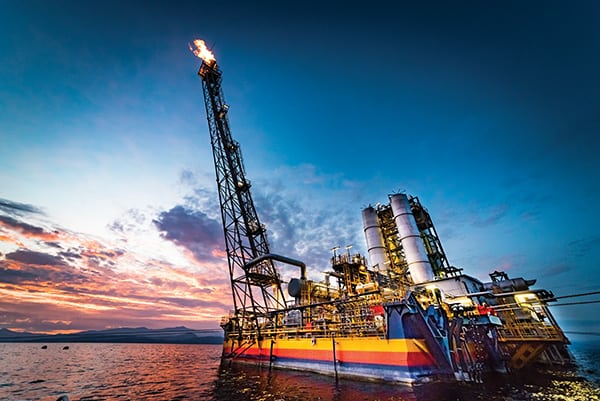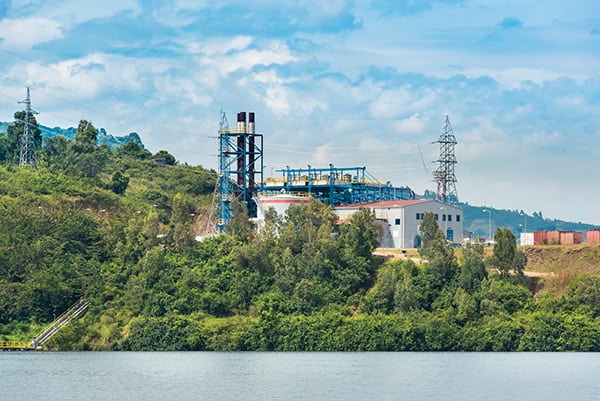Rwanda's Power Production Triumph over a "Killer Lake"
Lake Kivu, the 1,040-square-mile “killer lake” that stretches over the border between Rwanda and the Democratic Republic of Congo (DRC), has long been a source of trepidation.
Because it sits between two volcanic regions in the western branch of the Great Rift Valley, the deep, perpetually stratified lake’s bottommost waters absorb high concentrations of carbon dioxide (CO2) from magma-heated springs deep underground, and microbes convert much of the CO2 to methane. These dissolved gases are held in solution by pressures in the depths of the lake but can emerge if zones of high concentration move toward the surface, a process known as a limnic eruption, or “overturn.” Because the region is regularly subject to large-magnitude seismic events and volcanic discharges—and considering that methane has a high partial pressure—Lake Kivu is known to experience violent overturns. Geologists believe they occur at Lake Kivu about every 1,000 years—and that the lake is ripe for another.
Limnic eruptions occurred at much smaller Lakes Monoun and Nyos across the continent in Cameroon in 1984 and 1986 respectively, killing more than 1,700 people by asphyxiation. But an overturn at Kivu could be catastrophic and endanger millions of people living around its shores on both sides of the border because it contains far more dissolved gases than those two lakes.
Rwanda’s government has for years sought to extract the methane from Kivu’s depths, both to mitigate the risk of such a calamity and to generate power. Its efforts first came to fruition in 2008, when the country’s first methane-extracting and power-producing plant, a 3-MW pilot project, started operations.
Since then, the government has negotiated several methane gas concessions. Later in 2008, U.S.-based ContourGlobal, a firm that owns about 4,000 MW of capacity in 20 countries, including in Africa, entered into a partnership with the Rwandan government to transform the menace of the lake’s gas deposits into a 25-MW power plant, dubbed KivuWatt. The project subsequently garnered financial backing from the African Development Bank, the Emerging Africa Infrastructure Fund, the Netherlands Development Finance Co., and the Belgian Investment Co. for Developing Countries. In 2011, ContourGlobal contracted Finnish energy technology firm Wärtsilä to supply an engine-based plant with full engineering, procurement, and construction delivery.
The plant, which has been operational since December 2015 but was inaugurated in May, relies on two processes: methane extraction and power production. The gas extraction process, performed on a barge anchored 13 kilometers (km) offshore in Lake Kivu (Figure 1), brings gas-rich waters from a depth of 300 meters (m) and 35-bar pressure, reducing pressure to 2 bar in a gas separator, where gas bubbles are extracted from the water. Raw gas is then washed in four wash towers, ContourGlobal explained.
 |
|
1. A killer lake reformed. Methane is drawn from Rwanda’s Lake Kivu at a depth of 300 meters by a special barge anchored 13 kilometers offshore. Courtesy: Werner Krug |
The clean gas is then transported to the power plant (Figure 2) via pipeline, where three Wärtsilä 34SG engines use it as fuel. According to Wärtsilä, the engines are optimized to run on Lake Kivu’s gases, which have a lower heating value than standard natural gas. “This has helped to downsize the size of the extracting barge and optimize the costs of producing electricity,” it said in a statement.
ContourGlobal noted that the design and technology is performing “even better than expected,” and projects that the gas extraction facility will support at least an additional 9 MW of power generation, likely by the end of 2016.
For Rwanda, the project is proving valuable beyond its power production, underscoring its contribution to the region’s socioeconomic development. ContourGlobal is working with the local population, training and developing local workers to run KivuWatt and future installations. The project has also generally promoted peace with the DRC (the border area has suffered from intermittent conflict for decades), which is also reportedly considering a similar project, the government said.
Rwanda is now planning a second phase that will involve two or three barges to generate an additional 75 MW.
—Sonal Patel, POWER associate editor.
